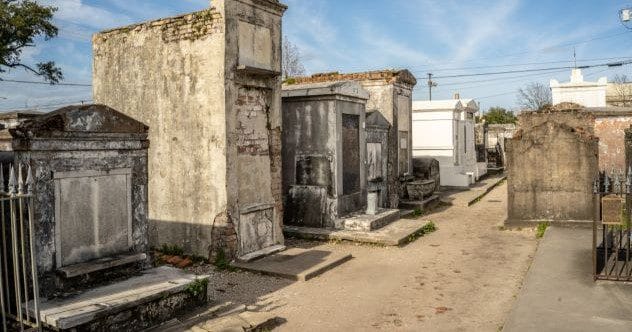New Orleans. The name alone conjures images of vibrant music, delicious food, and a certain mysterious charm. But delve a little deeper, and you’ll find a city with a unique relationship with its departed. Its famed cemeteries, with their elaborate above-ground tombs, aren’t just final resting places; they’re historical landmarks echoing tales of resilience, tradition, and adaptation. Ever wondered why New Orleans buries its dead above ground or what secrets these “cities of the dead” hold? Prepare to journey into the fascinating world of New Orleans’ burial practices.
10. Below Ground Burials Didn’t Work
You’ll find about 15 cemeteries in New Orleans featuring those iconic above-ground tombs. The primary reason for this unique style comes down to the city’s geography. New Orleans was established in 1718 on a raised bank near the Mississippi River. While this spot seemed ideal, early settlers quickly found a grim problem. The land, a natural levee formed by river deposits, had a high water table. Come flood season, this water would push buried coffins right out of the ground, like corks popping from a bottle. Imagine the horror of remains washing through the city streets! Additionally, many early New Orleanians hailed from France and Spain, where above-ground burials were already common practice. So, it was a mix of practical need and cultural tradition.
9. Yellow Fever Created Many of the Cemeteries
During the 18th and 19th centuries, yellow fever epidemics repeatedly struck the United States, with port cities like New Orleans being hit particularly hard. The disease was often brought in by ships from the Caribbean. Before 1822, outbreaks reached as far north as Boston, but afterward, it became primarily a scourge of the South. Between 1817 and 1905, when a vaccine was finally developed, yellow fever claimed over 41,000 lives in New Orleans alone. This staggering death toll necessitated the creation of numerous cemeteries. For example, St. Louis Cemetery #2 was established in 1823 specifically to accommodate victims of the epidemic. In 1853, a particularly devastating year, St. Louis Cemetery #3 was opened after more than 8,000 people died from yellow fever in just three months.
8. Below Ground Burials Were Once Illegal
To combat the problem of floating coffins and the spread of disease, New Orleans made a significant move in 1803. The city officially declared that all burials must take place above ground. At the time, people believed diseases like yellow fever spread through “miasma,” or bad air, thought to emanate from corpses. However, things changed. Today, below-ground burials are legal and quite common in New Orleans. This shift became possible thanks to a pumping system invented by Albert Wood in 1914, which helped drain the city. This innovation allowed those whose religious beliefs required in-ground burial to do so. You’ll find Jewish and Protestant cemeteries with below-ground graves. The Catholic Church, owning 13 of the city’s 43 cemeteries, largely continued with above-ground tombs, a practice Protestants also adopted out of necessity, calling it the “Latin” form of burial. These pumps also improved sanitation, helped control mosquito populations (reducing malaria), and provided cleaner drinking water.
7. An Old Cemetery Lies Below the French Quarter
Believe it or not, a historic cemetery rests beneath parts of the modern-day French Quarter. From 1723 to around 1800, the city’s primary burial ground was St. Peter Cemetery, located just outside the then-smaller French Quarter. When the Spanish took control of Louisiana in 1762, they realized by the 1780s that the growing city and its high mortality rate needed a new cemetery. The original St. Peter Cemetery, situated closer to the Mississippi, was deemed harmful to the levee. Heavy rains turned it into a bog, with bodies floating to the surface. Eventually, around 1800, this cemetery was closed, paved over, and built upon, largely forgotten. However, remnants are still discovered. In 2011, a resident unearthed fifteen coffins while building a swimming pool, now locally nicknamed the “pool of souls.” These coffins, weighing 600–800 pounds each, were packed tightly together. Remarkably, the remains found were of African or Native American descent, highlighting the city’s multicultural past. It’s estimated that 8,000 to 12,000 people are buried under this section of the French Quarter.
6. Above-Ground Tombs in New Orleans Hold Multiple People
Many Americans think of above-ground tombs as a New Orleans invention, but they were actually popular in French and Spanish cities long before. The Spanish introduced them during their colonial rule. Most tombs in New Orleans are family-owned and can house numerous individuals. This is possible because they function like slow-burning ovens. A deceased person is placed on a shelf inside the tomb for a period of “a year and a day,” a custom rooted in Judeo-Christian traditions about returning “ashes to ashes, dust to dust.” After this time, the remains are either pushed to the back or moved to a lower chamber. Thanks to the area’s high heat and humidity, bodies naturally decompose and cremate over 50 to 60 years. This system allows multiple generations, sometimes up to 60 people or more, to rest within a single family tomb.
5. Bodies Are Often Placed Inside Walls
It’s not just the grand tombs; bodies are even interred within the cemetery walls in New Orleans. As space grew limited, wall vaults, also known as oven vaults, became a cheaper and more space-efficient way to lay the dead to rest, especially during the peak of yellow fever epidemics. These vaults were also used as temporary or “rental tombs.” If two family members passed away within the “year and a day” period (a common occurrence during an epidemic), the second person might be placed in a wall vault. Once the year-and-a-day period passed, their remains could then be moved to the family’s main tomb’s lower chamber. Many of these wall vaults are reused and can sometimes hold the remains of up to ten people each.
4. Above Ground Tombs Originate from Roman Times
The concept of wall vaults in New Orleans cemeteries has ancient roots, drawing loose inspiration from Roman burial sites known as columbaria. While Roman columbaria were typically underground chambers carved from rock and used to store urns with cremated ashes, rather than whole bodies like in New Orleans, the structural idea is similar. These Roman burial chambers were often beautifully designed and could hold thousands of remains. The wall vaults of New Orleans are above ground and generally less ornate than their Roman predecessors, but they still represent a clever adaptation to burial challenges.
3. Society Tombs Took Care of People in Life & Death
Not everyone in old New Orleans could afford a private family tomb. This led to the formation of “Benevolent Societies.” These organizations provided crucial support to their members, including medical services, community events, and, importantly, a final resting place. The first such group, the Perseverance and Mutual Aid Association, was formed in 1783 by newly freed African people. Later, immigrant groups, religious orders, and less wealthy French and Spanish residents also formed these societies. While once common worldwide, these societies are still a living tradition in New Orleans. The Italian Benevolent Society tomb in St. Louis Cemetery #1 is one of the most striking. It famously (and without archdiocese permission) appeared in the 1969 film Easy Rider. This controversial scene, filmed guerrilla-style while the actors were reportedly under the influence of LSD, led the archdiocese to ban most filming in the cemetery, a rule that largely stands today.
2. The Tombs Are Cleaned and Maintained by Families
All Saints’ Day, November 1st, is a deeply cherished tradition in New Orleans. Originally, the Catholic Church honored saints on their individual feast days. However, as the number of saints grew, Pope Boniface IV established All Saints’ Day in the seventh century to honor them all at once. Pope Gregory III later moved it to November 1st in the eighth century. The first All Saints’ Day in New Orleans was observed in 1742. Today, this day sees families visiting their ancestral tombs to clean and decorate them. They often leave gifts like flowers, photographs, food, and even alcohol. While practiced in many Catholic countries, the vibrant observance of All Saints’ Day in New Orleans is unparalleled in the United States.
1. Funeral Processions Include a Musical Element
“Second Lines,” often called Jazz Funerals, are a unique cultural tradition born in New Orleans. These processions were one of the services offered by benevolent societies. Initially, a brass band would play somber music as they accompanied the procession. In 1875, the “Société d’Economie et d’Assistance Mutuelle,” a Black benevolent society, officially designated “brass band” music for these events. Following the solemn dirge, it became customary for the band to switch to joyful, upbeat music. By 1883, these lively processions were also used for the societies’ annual parades. Today, Second Lines are a common sight, used for both funerals and various celebrations throughout the city. They are a vibrant expression of New Orleans’ culture, where life and death are closely intertwined, and the departed are revered and celebrated with music and spirit.
New Orleans’ burial customs are a captivating blend of practicality, history, and deep-rooted cultural traditions. From the iconic “cities of the dead” to the lively jazz funerals, the way New Orleans honors its departed is unlike anywhere else, reflecting the city’s unique spirit and resilience.
What do you find most fascinating about New Orleans’ burial practices? Have you ever visited these historic cemeteries? Leave your comment below!










